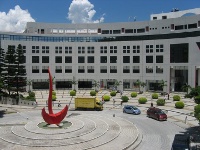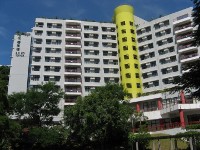History of HKUST
The Hong Kong University of Science and Technology (HKUST, 香港科技大學) belongs to the three most renowned universities in Hong Kong. Founded in 1991, HKUST celebrated its 20th anniversary in 2011. This is a surprising fact from an European point of view. Being built literally from scratch on the beautiful coastline of Clearwater Bay, HKUST made an ambitious and steep ascent in the last two decades. In January 2011 about 10.000 students were studying at HKUST as compared to a number of roughly 500 people employed in teaching [1]. HKUST is a campus university. Lecturing facilities, student residences, sport facilities, a supermarket and food courts turn the campus into a vivid place where students and teachers not only come for university quests but also spend parts of their free time. HKUST has a strong focus on business and engineering. The international setting provides students, teachers, and researchers from abroad with a welcoming international atmosphere. HKUST is a partner university of Technische Universität München. The QS Asian University Ranking 2011 designated HKUST to be the best university in Asia [2].Campus
The campus is located in the east of Kowloon, around 30 minutes away from city center by public transport, the latter requiring a large fleet of minibuses (小巴) [3] that connects the campus with the nearest subway stations. HKUST is built on a hillside and offers a magnificient view upon Clear Water Bay. The panoramic view onto the South China Sea is reason enough for even tourists come visit the campus. All buildings on the campus are within walking distance, though one often needs to take elevators to cover the height difference of around 30 stories between the sea level and the main campus building. The campus offers a wide range of facilities, which makes it very attractive for both local and foreign students to live there. The campus is still growing in order to cope with a growing number of students.Programs
The academic year at HKUST is divided into four terms. There are different schools, namely the School of Science, the School of Engineering, the School of Business and Management among a few other smaller ones [4]. Study programs are categorized into undergraduate programs and postgraduate programs. Usually, undergraduate studies (Bachelor of Science, Bachelor of Engineering, Bachelor of Business Administration) take 3 years and 120 credits [5] [6], yet a major change to a 4-years undergraduate program is upcoming in 2012 [7] [8]. For postgraduate programs (Master of Science, Master of Philosophy, PhD) the duration strongly depends on the program [9] [10]. HKUST requires some undergraduates to take a preparatory year. For example, the preparatory year is mandatory for students from Mainland China, but not for students holding the German Abitur or the French Baccalaureate [11]. The admission scheme at HKUST differentiates between education systems from all over the world. For example, HKUST expects German students to have an Abitur grade between 1.0-2.0 in order to be competitive in the admission process [11]. Student ambassadors help answer questions about the university for interested applicants, a pragmatic approach that allows establishing contact to already enrolled students prior to admission [12]. The university charges tuition fees from all its students, except for exchange students of partner universities. The tuition fees are high compared to Germany; for non-local students HKUST charges HKD 100,000 (around EUR 10,000) per academic year [13]. For local students, the tuition fee is HKD 42,100 (around EUR 4,200) per year [14].Courses
HKUST has a well-organized and centralized course registration scheme [15] [16]. Most of the courses only allow a limited number of participants. The course registration is turn-based. As such, every student will be assigned a randomized registration period of a few days. In this period, a student is able to register for all courses in the upcoming term. Conflicts in a schedule are not allowed. The approach with randomized registration periods avoids the problems that tag along with a first-come first-serve approach (other universities that use FCFS for allocation often suffer denial of service due to students all sending requests at the same time). A second period allows for dropping or changing courses and enables some students to take a course after having been on the waiting list. Courses at HKUST are conducted in English. The teachers are generally proficient in English. The students' English skills vary but all of them understand English well. The courses at the School of Engineering are mostly accompanied by lab sessions and tutorials. Students are required to work on assignments at home. The assignments influence the final grade. Good students who achieve a certain grade point average in the courses are granted the Dean's list award. Teachers tend to explain abstract concepts by example, thereby leaving it up to the students to generalize. Questions during lectures are generally welcome.Library
The library is definitely one of the campus highlights. Not only is it well-spaced and well-equipped, but it also offers a rewarding view through a multi-story glass front down on the ocean. At least the upper stories of the library are comparatively noisy with students chatting, dating, watching movies (with earplugs, though) or even talking on the phone. The lower levels are quiet and altogether with the convenient printers and helpful staff around, the library is an important place for students at HKUST.Computer Barn
There are multiple computer barns in HKUST, but the central one is usually the one which is most crowded and most frequently used. Webcam transmissions allow students to check online which barn has empty seats left. Smartcard readers next to each terminal allow students to conveniently buy print budget via their student card, or if not at hand, at the service desk. Whilst the lack of decent software and operating systems in the computer barns can quickly become annoying when one does not have an own notebook, the equipment and efficient organization in the computer barn gives an example for how HKUST effectively implements its high standards in practice. Apart from the computer barns, ubiquituous terminals in the hallways allow students to find rooms or other vital information online without requiring a smartphone.Food Courts
The campus hosts several canteens. They offer food at affordable prices, tend to be noisy around meal times. The canteens are a perfect place to learn the numbers Cantonese; a dish number is called when the order is ready. Canteens are popular places to meet and they offer breakfast, lunch, and dinner. The hot pot is especially popular with students.Student Housing
HKUST offers on-campus housing for around 4500 students making the campus a village by itself [17]. This means that almost every second student lives on-campus, which is also part of the holistic approach of HKUST to university studies. The result of the students living together on the same premises strongly supports tight networks among them. Undergraduate students share rooms with one or more roommates, and privacy is pretty much non-existent. Postgraduate students who live on-campus have rooms on their own. The students among each hall form communities (as students are often reassigned to another hall, these halls are not as rivaling as in J.K. Rowling's Hogwarts though). The halls are guarded by a security team that enforces rather strict rules from a European point of view. Some teachers also live on-campus. Even some families without relations to HKUST opt to live on the campus for its beautiful scenery and the convenient facilities in walking-distance.Facilities
Students and staff enjoy a wide range of facilities on the campus. To these belong tennis courts, a soccer pitch, a basketball court, table tennis courts, badminton courts, a gym, an indoor climbing wall, a swimming pool, a seaside barbecue site, a piano room. The use of these facilities is free of charge for staff and students. Additionally, bank, post office, grocery store, stationery shop, souvenir shop, hairdresser, doctor - all these facilities make life on campus extremely convenient.Societies
Many students belong to various student societies. These societies organize students who share interests, such as in soccer, running, hiking, sailing, Taekwando or even just plain business and management. These societies organize a lot of events and activities on the campus and around Hong Kong. Students invest tremendous efforts and time into societies as social and organizational skills are regarded as key qualifactions among the students.Personal opinion
HKUST is an excellent university that convinces by its holistic spirit; HKUST tries to view personal development and academic studies as two aspects of the very same challenge, and hence integrates all aspects of life with university. The new 4-years system is to overcome some limitations introduced by a strict curriculum and a quantity-oriented way of learning; an area where Hong Kong and HKUST can improve. The way HKUST is embracing change is highly encouraging.Sources
- HKUST Facts & Figures. http://www.ust.hk/eng/about/fh_facts.htm accessed 2011-12-21
- Asian University Rankings 2011. http://www.topuniversities.com/university-rankings/asian-university-rankings/2011 accessed 2011-12-21
- Public light bus. http://en.wikipedia.org/wiki/Public_light_bus accessed 2011-12-22
- HKUST Schools and Departments. http://www.ust.hk/eng/teaching/schools.htm accessed 2011-12-22
- HKUST Recommended Pattern of Study for Undergraduate Students. https://www.ab.ust.hk/arr/reg/in/pos/pos1112.html accessed 2011-12-22
- HKUST Undergraduate Programs. http://publish.ust.hk/prog_crs_ar/ugprog/index.html accessed 2011-12-22
- HKUST 4-Year Undergraduate Program. http://334.ust.hk accessed 20112-12-22
- Hong Kong's Education System. http://studyinhongkong.edu.hk/eng/01hkesystem.jsp accessed 2011-12-23
- HKUST Postgraduate Programs. http://publish.ust.hk/pgstudies accessed 2011-12-22
- HKUST Research Postgraduate Programs. http://publish.ust.hk/prog_crs_ar/pgprog/index.html accessed 2011-12-22
- HKUST Undergraduate Admissions. http://join.ust.hk/apply accessed 2011-12-22
- HKUST Ask a Student. http://join.ust.hk/apply/non-local/ask-a-student accessed 2011-12-22
- HKUST Admission for International Applicants. http://join.ust.hk/apply/non-local/fees-and-support/what-does-it-cost accessed 2011-12-23
- HKUST Admission for Local Applicants. http://join.ust.hk/apply/non-jupas/info-guide/information-guide accessed 2011-12-31
- HKUST Undergraduate Courses. http://publish.ust.hk/prog_crs_ar/ugcourse/index.html accessed 2012-01-02
- HKUST Postgraduate Courses. http://publish.ust.hk/prog_crs_ar/pgcourse/index.html accessed 2012-01-02
- HKUST Facts & Figures Sheet. http://www.ust.hk/eng/images/about/pdf/hkust_facts_and_figures_Eng.pdf accessed 2011-12-22
- HKUST Academic Regulations. http://www.ust.hk/provost/ug/acd_reg/index.htm accessed 2011-12-22







